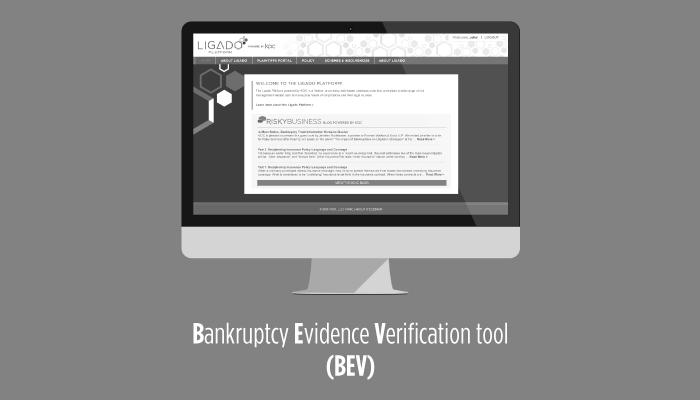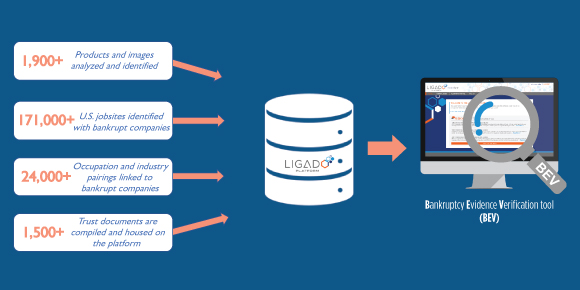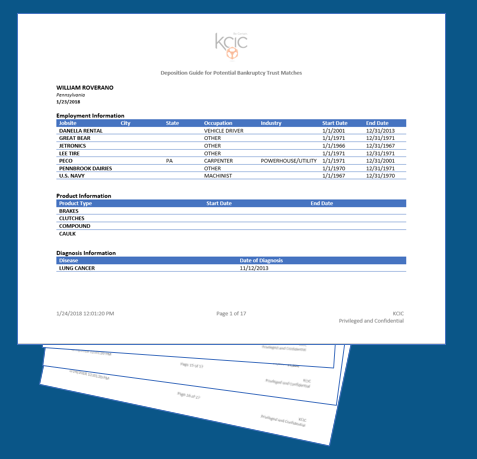

It was a pleasure to host two webinars in the last month, during which we took a close look at our BEV, Bankruptcy Evidence Verification, tool. We began by going back to the beginning — why and how we created BEV. I walked through a demo that included our latest updates to BEV, which make searching bankruptcy trust information easier than ever before. Finally, we took questions from the audience, which represented various members of defense groups.
If you didn’t have a chance to participate in one of the webinars, we wanted to share some highlights:
Why We Created BEV
Through our research on the Garlock abuses and conversations with many of our clients, we saw a need for a tool that identified potential connections between asbestos claimants in the tort system and bankruptcy trusts. Furthermore, we envisioned a tool that would be operable and autonomous in the hands of defense.
We got to work, involving our clients and their counsel along the way. We gathered documents from bankruptcy trusts, including jobsite, significant occupational exposure (SOE) and product listings, then standardized this information so that everything would be available in one place through BEV. The BEV tool is now an ever-growing database — as trusts update information, we monitor and make updates in our system as well. BEV has also become a tool we are proud to say is collaboration-based — we continually make updates based on user feedback.

Questions You May Have
Below are a handful of questions that participants had during our BEV webinars. Maybe you have some of the same questions. We hope providing the answers here is helpful:
Does BEV provide access to trust claims submissions?
BEV does not house any trust claim submissions made by claimants. It is our understanding that most trusts require a subpoena in order to obtain trust claims made by specific plaintiffs. As a result, the trust claim submissions are not something KCIC has direct access to. We do, however, have BEV connected through the claims administration integration, as discussed below, where you can track information learned about claimant trust filings. Trust claims submissions obtained by counsel during the course of discovery can be loaded to claimant pages and linked to this trust tracking section for each claimant.
Are there future plans in place to link other types of alternative exposure evidence to bankrupt companies?
Our hope is that over time, BEV will become a resource for all solvent defendants to keep bankrupt companies in evidence. If there are other evidentiary materials that prove sources of exposure to bankrupt companies, such as site diagrams, product pictures, product catalogues, depositions, and interrogatories, feel free to send them our way and we would be happy to incorporate them into BEV.
Can defendants collaborate on BEV reports if they are working on research for the same claimant?
Currently, BEV is not set up to let users share and collaborate on reports; however, it is a capability we have considered adding in the near future. If this capability existed for BEV:
Multiple counsels, for example NCC and LDC, could work on and review a report simultaneously for their client.
A handful of defendants could work together to prepare a BEV report that could be used as a deposition aid. Then as information is learned by each defendant through depositions, they can collaborate to supplement the existent BEV report with any new exposure information learned, creating a thorough BEV report for joint-defense.
What are the different ways I can access the BEV tool?
Currently we offer BEV access in two ways:
Standalone BEV Portal: Through this access, you have the ability to search KCIC’s database of bankruptcy trust and trust transparency information. In addition, you have access to a reporting feature that allows for ad hoc reporting based on user-entered claimant information. The reporting creates a claimant specific trust report that can be printed and used in deposition, trial or in settlement negotiations — we have included an example below. This means of access can be for a defendant’s entire counsel network, or for a single law firm. Pricing is billed per report.
Claims Administration Integration: For defendants that use KCIC for their claims administration, BEV reporting can be integrated into each claimant’s page. Since basic exposure information is typically entered for each claimant upon processing the complaint, an initial BEV report can be run at the click of a button. The report is still claimant-specific and can be printed, like the report example below. In addition, you have access to a claimant trust tracking report that allows you to document information learned about the claimant’s history with the trust. You can document if the claimant made a trust claim submission, link obtained trust claims documents, or note that the claims documents have been requested but not received yet from the trust. Claims administration access also grants you the ability to search KCIC’s database of bankruptcy trust and trust transparency information. This means of access is typically for a defendant’s entire counsel network. Pricing is billed by subscription.

Thank you to all who attended one of our webinars. It was a new experience for us to share one of our tort system tools live online to such a large audience, and your questions and feedback were greatly appreciated.
Missed the webinars but interested in learning more about BEV? Please don’t hesitate to contact us at BEV@kcic.com.
Never miss a post. Get Risky Business tips and insights delivered right to your inbox.

Kathrin Hashemi has partnered with her clients on a variety of matters including litigation management, insurer billing arrangements, claims administration, and asbestos bankruptcy trusts. Much of her work has allowed her the opportunity to have a more holistic understanding of the litigation at hand, while simultaneously being able to solve complex problems for her clients.
Learn More About Kathrin